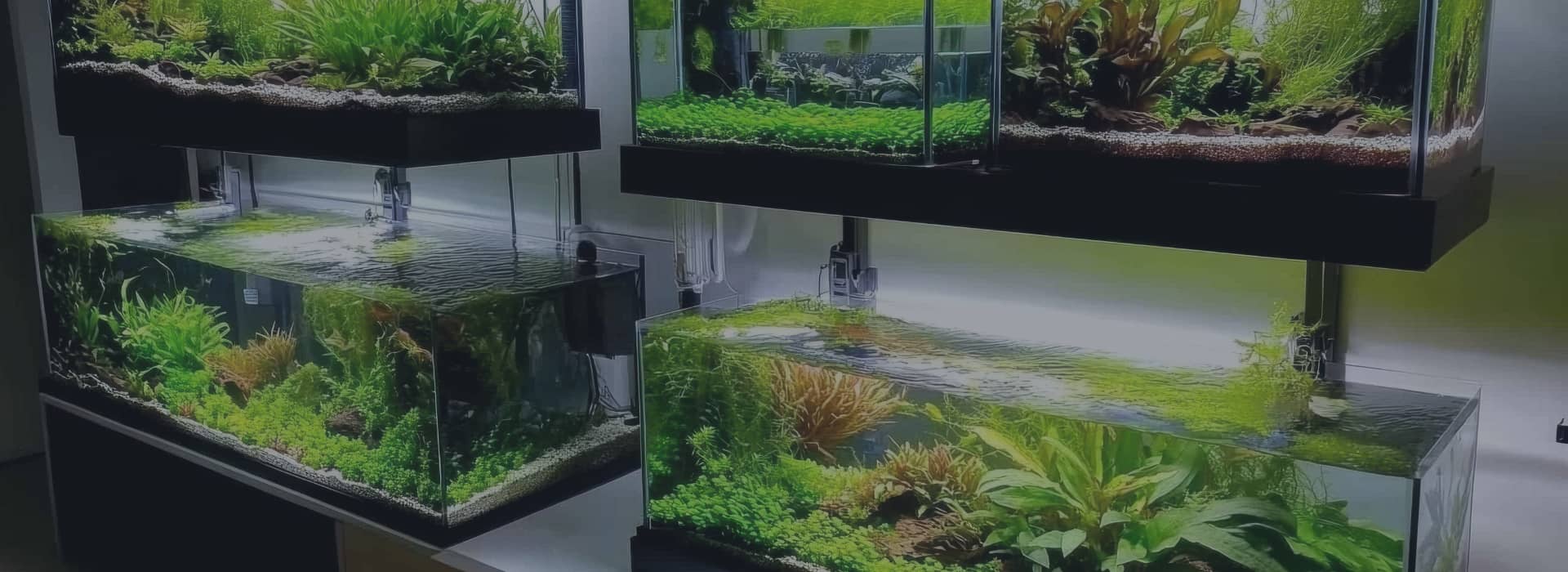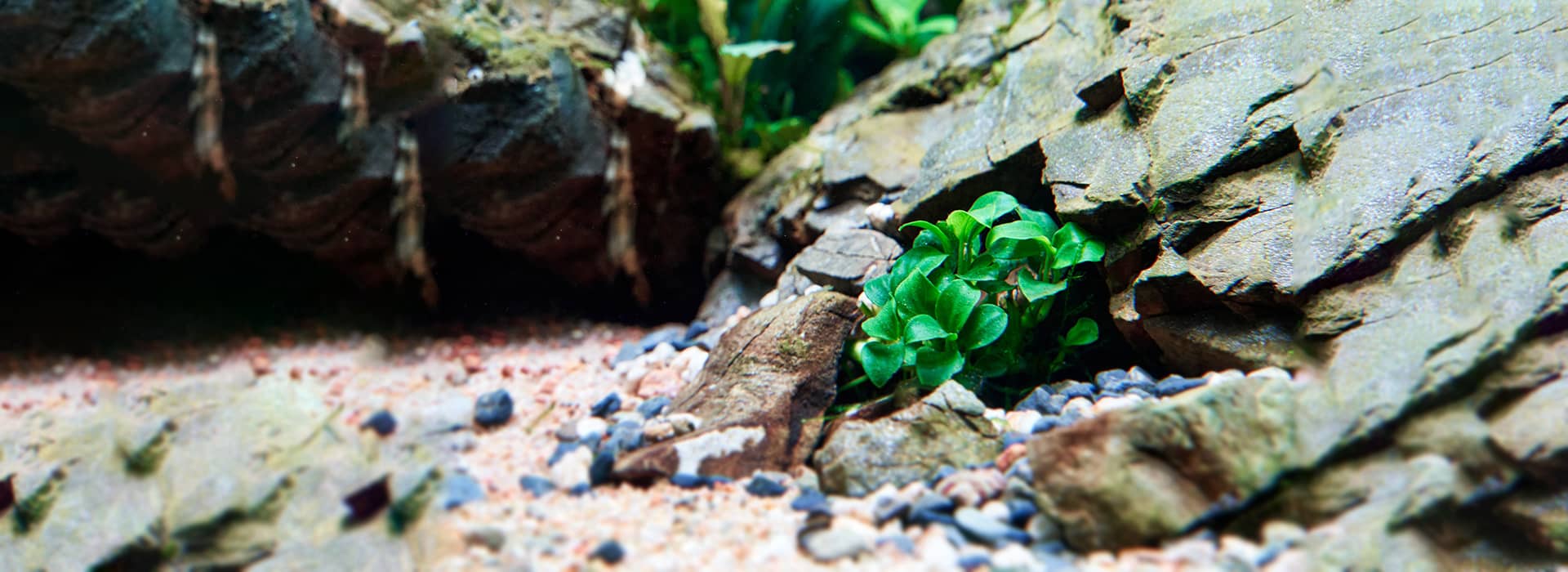Native to the tropical waters of Southeast Asia, the Kuhli Loach is a peaceful bottom-dweller with an eel-like body and distinctive stripes. If you want an interesting and off-beat fish for your community tank, then the Kuhli loach is definitely an option worth considering. With a lifespan of up to 10 years, it can be a long-term addition to your planted aquarium as long as it receives proper care.
At a Glance
| Common Name | Kuhli Loach |
| Scientific Name | Pangio kuhlii. |
| Size | 2 3⁄4 inches (7 cm) to 4 inches (10 cm) |
| Lifespan | 10 years |
| Habitat / Native To | Java, Indonesia |
| Diet | omnivore |
| Tank Mates | tetras and rasboras |
| Colour | black brown stripes with salmon pink to yellow in between |
Overview
The Kuhli Loach has slightly flattened sides and displays 10 to 15 dark brown to black vertical bars, with salmon pink to yellow gaps between them. The underside of the body is light in colour.
Kuhli Loaches’ fins are notably small. The dorsal fin begins behind the midpoint of the body, while the anal fin is positioned even farther back.
Their head is relatively small, with a slightly pointed snout and small, downturned mouths. It features four pairs of barbels around its mouth.
Kuhli Loaches have small eyes situated towards the top of their heads, allowing them to observe their surroundings while partially buried in the substrate. The eyes are covered by transparent skin.
The scientific name for the true Kuhli Loach is Pangio kuhlii. However, similar-looking loaches are sometimes sold as Kuhli Loaches.
One of these is the Half-banded Kuhli Loach (Pangio semicincta), which is actually a different species within the same genus. To be fair, even scientists considered them the same or synonymous species before. It was only in 1995 that they were considered distinct.
Myer’s Kuhli Loach or Giant Kuhli (Pangio myersi) is also sometimes confused with other striped loach species, especially when young. It is quite similar in appearance but has a much heavier build than Kuhli and Half-Banded Kuhli Loaches.
These similar-looking species require the same care as the true Kuhli Loach.
Native Habitat
True Kuhli Loaches are endemic to Java, Indonesia. Other species can be found in Thailand, Malaysia, and other parts of Indonesia. Specifically, they are found in slow-moving or still waters such as swamps, marshes, and the lower reaches of streams.
Behaviour
Kuhli Loaches exhibit peaceful behaviour both among themselves and with other fish species. There are no documented reports of them causing harm to tankmates, although they may occasionally prey on eggs or fry.
In their natural habitat, these loaches are often found in large groups. When kept in captivity, they tend to huddle together in a single nook, cranny, or cave during rest periods. They are active at night.
Aquarium Setup
Tank Size
A minimum tank size of 57 litres (15 gallons) is recommended, though larger is always better to accommodate their active swimming behaviour. If keeping multiple fish, add three to five gallons for each additional Kuhli Loach fish.
Substrate
To create a comfortable habitat for Kuhli Loaches, start with a soft, sandy substrate to mimic their natural environment. This not only caters to their burrowing instincts but also prevents damage to their delicate barbels.
Water Conditions
Water conditions should be kept stable, with temperatures ranging from 73°F to 86°F (22 °C to 30°C) and a pH level between 5.5 and 6.5. Soft water with a hardness of less than 5.0 dGH is ideal for these loaches.
Regular water changes and a good filtration system are crucial for maintaining high water quality and keeping your Kuhli Loaches thriving. Make sure to cover the filter inlet with a mesh to keep your fish from getting stuck.
Aquascaping
To give them hiding places, add driftwood, caves, and live plants such as Java ferns and peat moss.
Tank Mates
Kuhli Loaches are known for their peaceful and shy nature, making them excellent tank mates for other non-aggressive fish.
They do well with small schooling fish, such as tetras and rasboras, which do not compete with them for bottom-dwelling space.
Avoid housing them with large or aggressive species that may stress or harm these gentle loaches.
Feeding
Kuhli Loaches are primarily bottom dwellers that feed on small organisms like insects, worms, and crustaceans in their natural habitat. In captivity, provide them with a varied diet that meets their nutritional needs. Here are some tips for feeding Kuhli Loaches:
- Offer a varied diet: Kuhli Loaches are omnivores and should be offered a mix of plant—and animal-based foods. You can feed them sinking pellets, flakes, frozen or live foods such as bloodworms, brine shrimp, and daphnia. Make sure to vary the types of food you offer to ensure they receive a balanced diet.
- Feed at night: Kuhli Loaches are nocturnal and prefer to feed at night. Try offering food just before turning off the aquarium lights or use a specialised nocturnal feeding stick to feed them after lights out.
- Use a feeding dish: Kuhli Loaches are bottom dwellers and can sometimes have trouble finding food in a community tank with other fish. Using a feeding dish or sinking food near their hiding places can help ensure they get the food they need.
- Avoid overfeeding: Like all fish, Kuhli Loaches can be prone to overeating, which can lead to health problems. Feed them small amounts of food 2-3 times per day and remove any uneaten food after a few minutes to avoid water quality issues.
Common Health Issues
Ich or White Spot Disease
White Spot Disease, or Ich, is a parasitic infection characterized by white spots on the skin, gills, and fins.
This contagious and rapidly spreading disease affects many freshwater fish species, including Kuhli Loaches. It’s caused by a parasitic ciliate called Ichthyophthirius multifiliis, which penetrates fish’s gills, skin, and fins.
To prevent Ich or any other infections, you must quarantine new fish for a minimum of 30 days before introducing them to a tank.
If you confirmed an outbreak of ich, you should start appropriately timed and repeated treatment immediately.
A single-dose treatment will not be enough. The parasites in the adult feeding stage (trophont) are protected by the fish’s epithelial tissue and mucus and will not be affected by the treatment.
Similarly, when they are in the reproducing stage (tomites), they are protected by a gelatinous-walled outer cyst.
Only the free swimming theronts are susceptible to chemical treatment because they are unprotected. Repeated treatments will kill the parasites at this stage of their life cycle.
You should also consider the water temperature when timing the treatment. Warmer temperatures speed up the life cycle of the parasite in 3-6 days, so daily chemical treatments are needed. When the temperature is cooler, treatments should be spaced every three to five days.
Formalin and copper sulfate are typical chemicals used for ich treatment. When using these chemicals, follow the guidelines.
After treatment, remove organic debris to reduce the number of emergent theronts.
Flukes
Flukes are parasitic worms that attach to the fish’s skin or gills, causing irritation and increased mucus production.
The most common ones infecting fishes are Dactylogyrus spp (gill) and Gyrodactylus spp (skin). Technically, they are not really flukes but Monogeneans. However, the term flukes is now commonly used to refer to these worms.
As mentioned, quarantining new fish will prevent the spread of parasitic infections, including flukes. Treatment typically involves anti-parasitic medications or chemical treatments.
Bacterial Infections
Kuhli Loaches are prone to bacterial infections, including Columnaris, a disease caused by Flavobacterium columnare.
This disease manifests as white or greyish spots on the head, fins, or gills, which eventually evolve into lesions.
The mouth lesions have a cottony appearance, which is why it is also referred to as Cotton Wool Disease.
Fin Rot is another bacterial infection that may affect Kuhli Loaches. Infected fish have frayed, discoloured, or decaying fins. Several bacteria types, such as Aeromonas, Pseudomonas, or Vibrio, can cause this disease.
However, it typically only manifests when the fish’s immune system is compromised, such as during periods of stress or exposure to less-than-ideal conditions.
The most effective method to ward off bacterial infections is to create an optimal environment for the fish. Maintain the tank meticulously and avoid overcrowding. Ensure compatibility among tankmates to eliminate potential stressors.
To treat bacterial infections, isolate the sick fish in a clean tank with well-filtered water. Then, apply appropriate antibiotic medication. Always check with your fish vet when using medications.
Fungal Infections
Fungus usually appears on fish as cotton-like growths. Antifungal treatments and improving tank conditions are effective ways to treat this issue.
Preventative Measures
- Regular water testing and maintenance to keep the water parameters within the ideal range.
- Quarantining new fish before introducing them to the main tank to prevent the spread of disease.
- Providing a balanced diet and proper nutrition to keep the fish healthy and robust.
Breeding
Breeding Kuhli Loaches in a home aquarium can be very challenging, as they are notoriously difficult to sex and often require specific environmental conditions to trigger spawning. However, with the right setup and some patience, it is possible to breed Kuhli Loaches in captivity. Here are some tips for breeding Kuhli Loaches:
- Sexing Kuhli Loaches: Sexing Kuhli Loaches can be difficult, but males are typically slimmer and have longer, more pointed dorsal fins. Females are generally rounder and fuller-bodied than males. Start with multiple juvenile Kuhli Loaches to increase your chances of getting them to pair up.
- Provide the right environment: Kuhli Loaches prefer soft, acidic water with a pH between 6.0 and 7.0. They also require a well-oxygenated aquarium with plenty of hiding places, such as plants or caves.
- Conditioning the breeding pair: To condition Kuhli Loaches for breeding, feed them a high-quality diet of live or frozen foods such as bloodworms, brine shrimp, or daphnia. You can also try varying the water temperature by a few degrees to simulate seasonal changes and trigger spawning.
- Spawning behaviour: Kuhli Loaches typically spawn at night, with the male wrapping his body around the female to release sperm and fertilise the eggs. The female will then lay eggs in a hidden area, such as a cave or plant leaves.
- Raising the fry: After spawning, the eggs will hatch in about 3-5 days. The fry will require a separate rearing tank with very fine filtration, gentle water flow, and plenty of live or frozen foods to eat.
Some Interesting Facts About Kuhli Loaches
- They are named after Heinrich Kuhl, a German naturalist who first described the species in the early 19th century.
- Kuhli Loaches are relatively long-lived fish and can live for up to 10 years with proper care.
- They have a unique way of swimming, which involves moving their bodies in a sinuous, eel-like motion.
Frequently Asked Questions
- Can I keep just one Kuhli Loach?
It is not recommended to keep just one Kuhli Loach as they are social creatures and thrive in the company of their own kind. A group of at least three to five is ideal to ensure their well-being. - Do Kuhli Loaches need a heater?
Yes, Kuhli Loaches require a stable, warm environment, so a heater is necessary to maintain the appropriate temperature range in the aquarium. - Can Kuhli Loaches eat algae wafers?
Kuhli Loaches can indeed eat algae wafers as part of a balanced diet that should also include other nutritious foods like sinking pellets and live or freeze-dried protein sources. - Will Kuhli Loaches eat my plants or other fish?
Kuhli Loaches are generally not known to eat healthy aquarium plants or harass other fish. They are scavengers and will mostly feed on food that reaches the bottom of the tank. - How many Kuhli Loaches should I get for my tank?
The number of Kuhli Loaches you can keep depends on the size of your tank. A general rule is to have a 20-gallon tank for a small group, allowing them ample space to roam and exhibit natural behaviours.
Kuhli Loach Care: A Rewarding Experience
Kuhli Loaches are fascinating and unique fish that make great additions to any freshwater aquarium. Their eel-like appearance, peaceful nature, and scavenging behaviour make them a great option for aquascaped tanks.
Kuhli Loaches are also relatively easy to care for, with minimal requirements and a hardy nature.
Their social behaviour and interesting swimming style make them a joy to watch, and their ability to help keep the aquarium clean adds to their appeal. Kuhli Loaches are an excellent choice for any community aquarium.
Caring for Kuhli Loaches can be a rewarding experience for any aquascapist. With the right setup, compatible tank mates, proper diet, and understanding of their behaviour, these fascinating fish will flourish in your aquarium, providing years of enjoyment.








